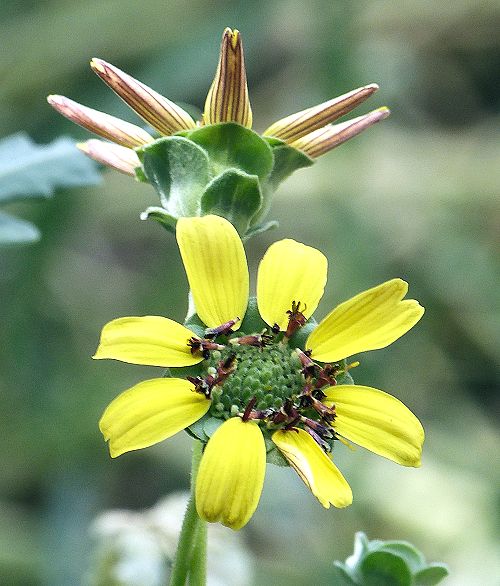Growing Berlandiera lyrata:
Chocolate Flower
Description
Form: Herb.
Lifespan: Perennial.
Leaf retention: Evergreen in frost-free regions.
Growth rate: Moderate to rapid, depending on water.
Mature Size: 1' (30cm) high and 2' (60cm) wide.
Flowers: The rays (female florets) are yellow on top and yellow and red striped underneath. The dark orange (male) florets, in the green center, have edible stamens with a chocolate fragrance. The scent is strongest in the early morning before the temperature rises. At noon, the rays may close up with full sun and high temperatures, but open again when the afternoon becomes cooler. In this flower, the ray florets produce seed and the center disc florets produce fragrance and pollen. If there are eight rays there will be eight seeds.
Bloom: Spring to fall.
Fruit: A dry fruit containing a single seed (cypsela) that develops at the edge of the disc where each ray attaches.
Leaves: Pale gray-green in full sun, green in part shade, many-lobed, at the base of the plant and part-way up the flower stalks. The leaves and stalks are plain and unattractive in full sun.
Stems: Erect, branched.
Roots: This plant has a deep tap root which makes transplanting difficult.
Wildlife: The flowers attract beneficial insects and butterflies. The seed attracts birds.
Toxic / Danger: No.
Origin: Arizona through North Carolina, Colorado to Missouri, south into Mexico.
Form: Herb.
Lifespan: Perennial.
Leaf retention: Evergreen in frost-free regions.
Growth rate: Moderate to rapid, depending on water.
Mature Size: 1' (30cm) high and 2' (60cm) wide.
Flowers: The rays (female florets) are yellow on top and yellow and red striped underneath. The dark orange (male) florets, in the green center, have edible stamens with a chocolate fragrance. The scent is strongest in the early morning before the temperature rises. At noon, the rays may close up with full sun and high temperatures, but open again when the afternoon becomes cooler. In this flower, the ray florets produce seed and the center disc florets produce fragrance and pollen. If there are eight rays there will be eight seeds.
Bloom: Spring to fall.
Fruit: A dry fruit containing a single seed (cypsela) that develops at the edge of the disc where each ray attaches.
Leaves: Pale gray-green in full sun, green in part shade, many-lobed, at the base of the plant and part-way up the flower stalks. The leaves and stalks are plain and unattractive in full sun.
Stems: Erect, branched.
Roots: This plant has a deep tap root which makes transplanting difficult.
Wildlife: The flowers attract beneficial insects and butterflies. The seed attracts birds.
Toxic / Danger: No.
Origin: Arizona through North Carolina, Colorado to Missouri, south into Mexico.
Cultivation and Uses
USDA hardiness zones: 4-10. This plant dies to the ground in freezes and comes back from its roots.
Heat tolerant: Yes.
Drought tolerant: Yes.
Sun: Full sun to part shade.
Soil: Well draining, dry to slightly moist, low organic content, pH 6.1-7.8 (slightly acidic to slightly alkaline). It gets leggy in enriched or fertilized soil. This plant is moderately saline tolerant.
Water after becoming established: Once or twice a month in part shade. Weekly in full sun. Avoid frequent watering to keep the plant from becoming leggy. Overly wet soil induces root rot.
Mulch: Use only inorganic mulch, such as gravel, if at all.
Planting: This flower can be planted in groups for a stronger fragrance.
Prune: If it gets too leggy, cut the flower stalks off. The plant will re-flower. Cut off spent flowers to provoke continuous blooming. This plant survives mowing.
Litter: Low except for pruning.
Propagation: Seed collected from the flower head. This plant easily self-seeds.
Uses: Ornamental, fragrance garden.
USDA hardiness zones: 4-10. This plant dies to the ground in freezes and comes back from its roots.
Heat tolerant: Yes.
Drought tolerant: Yes.
Sun: Full sun to part shade.
Soil: Well draining, dry to slightly moist, low organic content, pH 6.1-7.8 (slightly acidic to slightly alkaline). It gets leggy in enriched or fertilized soil. This plant is moderately saline tolerant.
Water after becoming established: Once or twice a month in part shade. Weekly in full sun. Avoid frequent watering to keep the plant from becoming leggy. Overly wet soil induces root rot.
Mulch: Use only inorganic mulch, such as gravel, if at all.
Planting: This flower can be planted in groups for a stronger fragrance.
Prune: If it gets too leggy, cut the flower stalks off. The plant will re-flower. Cut off spent flowers to provoke continuous blooming. This plant survives mowing.
Litter: Low except for pruning.
Propagation: Seed collected from the flower head. This plant easily self-seeds.
Uses: Ornamental, fragrance garden.
Comments
This plant is a member of the Daisy family (Asteraceae). Other common names are Chocolate Scented Daisy and Greeneyes.
Do you have additional information or a different experience for these plants that you would like to share? Email info@GardenOracle.com. All contributions are welcome and appreciated.
This plant is a member of the Daisy family (Asteraceae). Other common names are Chocolate Scented Daisy and Greeneyes.
Do you have additional information or a different experience for these plants that you would like to share? Email info@GardenOracle.com. All contributions are welcome and appreciated.



Latest update: September, 2024
© 2008-2025 by GardenOracle.com

